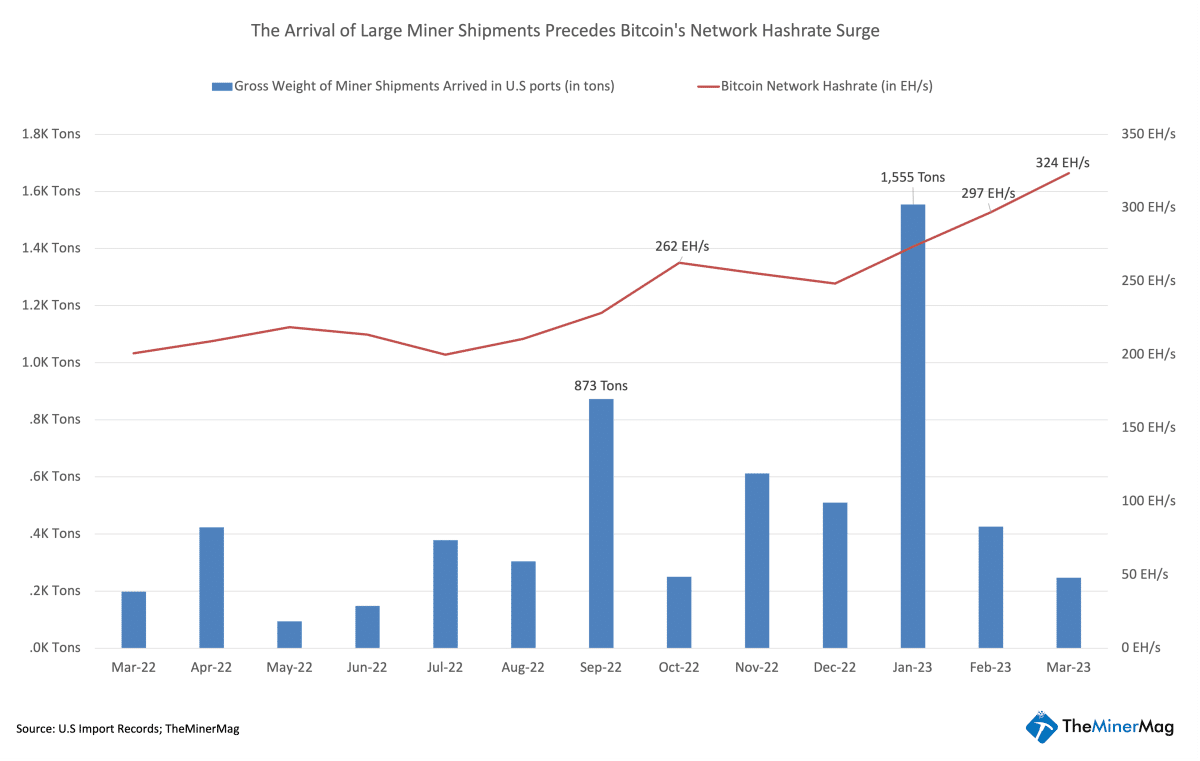A Look into 6K Tons of Bitcoin Miners Shipped to the U.S. Over the Past Year

Bitcoin’s seven-day moving average hashrate crossed the 300EH/s threshold for the first time in February and reached 330 EH/s earlier this month.
Bitcoin’s network hashrate is arguably the most fundamental metric in evaluating the dynamics of bitcoin mining. It is commonly understood that bitcoin’s hashrate tends to follow its prices and based on the recent market rally, it appears the hashrate jump will likely continue.
Meanwhile, other factors can indicate the network’s computing power too. One such factor is the miner shipment by major manufacturers, which has been largely unavailable due to the lack of data disclosures from Bitmain, MicroBT, and Canaan.
However, China’s notorious mining ban in 2021 led to the substantial growth of hashrate in the U.S., with shipments crossing the Pacific from major ports in Asia, including mainland China, Singapore, Hong Kong, Malaysia, Thailand, and Taiwan.
These ocean shipments resulted in useful U.S. import records that are now substantial enough to offer more color into the mining hardware market dynamics.
Total Shipments
Based on 12 months of U.S. import records since March 2022, TheMinerMag has found at least 240 shipments that arrived in the country with products believed to be solely bitcoin ASIC miners. The gross weight of these shipments totaled 6,000 tons.
The chart below breaks down the arrival month of the shipments and their corresponding total gross weight along with bitcoin’s monthly average hashrate. As the chart shows, January 2023 and September 2022 were the top two months by the total gross weight of bitcoin miners that arrived in the U.S.

Although the data only represented shipments into one country, it’s still interesting to see sharp increases in bitcoin’s hashrate (and hence network difficulty) in the following month(s), i.e. October 2022 and February 2023. Based on the trend reflected in the chart, if there’s no major uptick in the shipment gross weight in the rest of March and into April, the growth rate of bitcoin’s network hashrate may gradually slow down.
Breakdown by Manufacturers
It’s no secret that Bitmain has been the dominant bitcoin miner manufacturer with its AntMiner product line. Out of the 6,000 tons of identified miner shipments that arrived in the U.S., about 4,100 tons, or 68%, were believed to be the AntMiner S19 series.
Meanwhile, the gross weight of identified WhatsMiner and Avalon miners during the same period was 700 and 1,220 tons, respectively. However, it is worth pointing out that MicroBT shipped additional 888 tons of WhatsMiner parts to its U.S. factory partner Synos Corp, which then manufactures full products before hitting the market.
Based on the average unit gross weight of various miner models, the shipments were estimated to consist of about 236K AntMiner S19 series, 46K WhatsMiner M30 series, and 60K Avalon 12 series. With an assumed average hashrate of 95TH/s, these shipments would bring a total of 32 EH/s. Again, the estimation did not include the WhatsMiner parts that were shipped.
In a simplified calculation, the gross weight of the WhatsMiner parts that were shipped to Synos Corp would equal that of approximately another 60K units of full WhatsMiners. In that case, the total shipment market share breakdown would be identified as follows:
TheMinerMag intends to keep track of the miner shipment records for the coming months in an effort to evaluate if such records can be consistently telling of the network’s hashrate change in the future. The shipment records will result in additional analysis into the dynamics of the shippers, consignees as well as the most active states/ports in offloading bitcoin miners.







